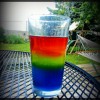
Turn your kitchen into a science lab and create a beautiful rainbow in a glass while teaching your kids about density. It ’s a fun chemistry experiment where kids can learn about not only density, but also mass and volume. Even without the science it ’s a fun project to do on a rainy day.
So head to the kitchen cabinets, pull out a few supplies, and create a lovely sugar water rainbow in a glass.
Supplies NeededFood coloring
Water
Granulated table sugar
4 glasses (at least one has to be clear to build your rainbow)
Serving spoon
Turkey baster
The Experiment
Start by adding sugar to each of the glasses. Each glass gets a different amount of sugar. The first gets 1 tablespoon, the second gets 2 tablespoons, the third gets 4 tablespoons, and the fourth gets a total of 8 tablespoons of sugar. The glass with 8 tablespoons of sugar needs to be the clear glass or the glass you want to build your rainbow in. It needs to hold at least 20 ounces of sugar/water solution.
To help keep the glasses straight, you may want to label each of the glasses with the amount of sugar they contain. Just put a sticky note under them and considered them labeled. You will need to know which one has how much sugar further down the line.
Next add four tablespoons of hot water to each glass. Stir the sugar/water solution until all of the sugar is dissolved. The sugar must be completely dissolved. If it doesn ’t seem to dissolve you can put the glass in the microwave for about 30 seconds and stir again. Eventually, it will dissolve.
After the sugar is completely dissolved, its time to add color to each of the glasses. We chose traditional rainbow colors, blue, green, yellow, and red. You can choose any colors you want. Just know that the glass that has the most sugar in it will go on the bottom of the rainbow, the glass with 4 tablespoons of sugar will be next, and so forth. Use about 2-3 drops of food coloring per glass and then stir.
Now comes the hard (but yet extremely rewarding) part. Layering the colored solutions. Start with the glass that has the most sugar. Ours was blue. The glass with the most sugar is the glass in which we are building the rainbow. Next, grab the glass with four tablespoons of sugar. Ours was green. We are going to add that next to our glass. Using the turkey baster suck up the green solution. Then place the serving spoon into the glass with the backside facing up and the tip of the spoon touching the glass above the blue solution. Slowly release the green solution onto the spoon into the glass. Since the green solution has less sugar, it will rest above the blue solution. If you pour it into the glass too quickly, the two colors will mix. It does take a little finesse, but is completely doable. Don ’t worry if they mix a little at first, they will separate as long as you take it slowly. Repeat this process with each of the remaining colors. Keep in mind that he first color is the easiest to put on, since it is the most dense. Each additional color becomes more difficult to keep at a slow stream when pouring it onto the other colors.
Voila!! You have a lovely rainbow in a glass! The solution will eventually mix, but it will remain separated for at least a day for the kids to enjoy. Beware though, they may want to drink it.
The Science Behind the Experiment
Now that we ’ve made this awesome rainbow, lets talk about the science behind it.
Density = mass divided by volume
Mass = the amount of matter an object contains (amount of sugar)
Volume = the amount of space an object takes up (the more sugar the more space it takes up)
For each of of the glasses we added more sugar (matter) making the solution more dense. You can even see from the individual glasses that even though they contain the same amount of water they contain varying volume since we added different amounts of sugar to each glass. The water layers since each color we added was less dense than the one prior. The less dense water solution floated to the top of the glass rather than mixing together.
More Density ExperimentsWhat happens if you stir up your density rainbow? Will the colors separate again?
What would happen if you added the least dense sugar/water solution to the glass first?
Think about other liquids around your house that might have different densities. Could you layer them? Oil, corn syrup, maple syrup, salt water, dish washing soap, rubbing alcohol?? Give it a try.
Try dissolving skittles into water. Use a different amounts of skittles into 4 tablespoons of water. 2 red, 4 orange, 6 yellow, 8 green, 10 purple? What would happen if you layered them?
Is salt water more dense than sugar water? Try it, and see.
Temperature can also affect density. Try layering different colors of water only. Use hot water, cold water, and room temperature water. Can you figure out which is more dense?
You can always do this same experiment with more colors. One layer can have no sugar, and others can have more than 8 tablespoons. Is there a point where there is not enough water to dissolve the sugar?
, Sugar Rainbow Density Experiment www.ozeldersin.com bitirme tezi,ödev,proje dönem ödevi
